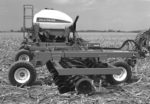Advertise Follow Us
Articles Tagged with ''John Deere''
New “Green Line” Seeding Era Emerges
John Deere recently introduced a number of new no-till planters, drills and air drills.
Read More
No-Till Online
Who Makes The Best No-Till Drill?
No-tillers provided the positives and negatives about many brands of no-till drills on the market.
Read More
Reduce Costly No-Till Planter Downtime!
New technologies can make no-till corn planting go faster and be more efficient.
Read More
No-Till Online
Solving No-Till Drill Choice, Bean Lodging Problems
Start your own debate at www.no-tillfarmer.com
Read More
No-Till Online
Equipment Modifications: Planters, Residue Managers & More
To join the discussions visit the Farmer's Forum: www.no-tillfarmer.com
Read More
Base Your No-Till Strategies On Technology, Patience
If you can envision a giant “Do Not Disturb” sign stretching over nearly 10,000 acres of northeastern South Dakota farmland, you’ll begin to understand the no-till philosophy of Cal and Erik Hayenga.
Read More
Part One Of A Series...
No-Till Boosts Yields While Saving Time
Being innovators and pulling together a total cropping package has paid big dividends for these highly successful no-tillers.
Read More
No-Till Online
Spaded Closing Wheels, Heave Limiters
To join no-till discussions, visit the Farmer’s Forum at : www.no-tillfarmer.com









